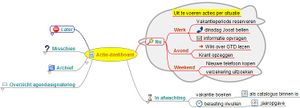Freeplane Tutorial Extensions
Contents
Tutorial 1.2.8
A tutorial Freeplane 1.2 is under development. This tutorial refers to didactic examples which will be developed below. Please contribute by giving your opinion and by providing didactic examples. The place to contribute is the Freeplane forum [1]. To view and navigate the tutorial, click on the image on the left.
Examples
Personal environment
Dashboard
When Freeplane opens it starts with a standard mind map. This map can be changed in a dashboard with direct access to the most important information at home and on the Internet. You can do this by simply dragging hyperlinks into your map. Besides you can add notes to hyperlinks to remember their meaning. Alo you can set signals to remember when you have to give attention to this information. This makes Freeplane paricular supportive in implementing Getting Things Done. <TO DO: Translate map to English>
Work environment
SWOT analysis
Mind maps can be supportive in carrying out all kinds of analyses. In this, Freeplane suports using images and arrows with labels to display concepts, which helps to keep oversight and focus. In cases these are not enough, Freeplane supports using hidden text which the user can roll down or hover. Click on the small triangles, or hover the cursor over the images to see a descriptive text.
School environment
Developing and giving a presentation
A map can be used to provide students with an assignement for a presentation, including directions, types of questions and links to litterature. The student can click the literature links to open the literature and add answers to the questions - in the map itself.
The map to the left contains a map with keywords for questions and literature links. For the advanced student these could be removed. Once the assigment is completed and the result is entered in the map, the map could be used to learn and do the presentation.
The map to the right contains model answers to the questions which could be used to check the result.
<To DO: translate the maps in English>
Animations
The following are some examples of animations. They were made in Dutch for FP 1.1.3 and need to be adapted to 1.2 and translated in English.




